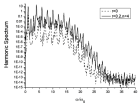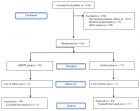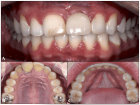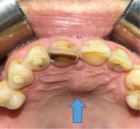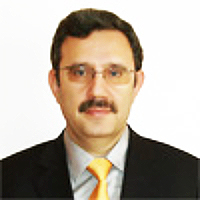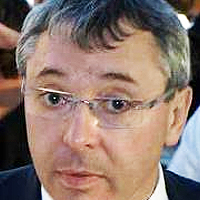Abstract
Research Article
Burden of hearing loss in Subsaharan Africa: Snapshot from an ENT clinic in Nigeria
Ogunkeyede SA*, Adebola SO, Daniel A and Adeyemo AA
Published: 31 December, 2019 | Volume 3 - Issue 1 | Pages: 001-005
Background: Disabling hearing loss is a prevalent public health issue, with significant impact on patients’ communication. The disability associated with hearing loss depends on the severity of the hearing loss. There are limited rehabilitative measures in resource challenged environment. This study assesses the incidence, the factors for hearing impairment and the management outcome.
Methods: A descriptive three-year chart review of patients managed for hearing loss in a tertiary health center in a developing country. The data collected include demographic data, clinical presentation and risk factors for hearing loss, audiometric reports, rehabilitative measures and management outcome.
Results: The patients with ear symptoms managed within the study period were 1350, of whom 498 (36.8%) had hearing loss of varying degrees. These included 145 (29.1%) males and 353 (70.9%) females with male to female ratio of 1:2.4. The age ranged from 8 to 80 years (median age of 35.7). Disabling hearing loss in the better-hearing ear occurred in 216 (43.4%) of cases. Increasing age and chronic supportive otitis media were associated with disabling hearing loss. The hearing thresholds improved with hearing aids and ear surgical procedures; nonetheless the patients’ rehabilitation was impaired by limited resources.
Conclusion: There is poor rehabilitation of people with hearing loss, though management outcome is commendable in a few of them. Health education will reduce the risk factors for disabling hearing loss and improved rehabilitative measures are needed for these individuals.
Read Full Article HTML DOI: 10.29328/journal.hor.1001016 Cite this Article Read Full Article PDF
Keywords:
Disabling hearing loss; Communication; Developing country Health education; Rehabilitation
References
- Turner JS, Per-Lee JH. Auditory Dysfunction: Hearing Loss. In: Walker HK, Hall WD, Hurst JW, editors. Clinical Methods: The History, Physical, and Laboratory Examinations. 3rd edition. Boston: Butterworths; 1990.
- Olusanya BO, Neumman KJ, Saunders JE. The global burden of disabling hearing impairment: a call to action. Bull World Health Organ. 2014; 92: 367-373. PubMed: https://www.ncbi.nlm.nih.gov/pubmed/24839326
- International Classification of Functioning, Disability and Health (ICF). Geneva: World Health Organization; 2001.
- World Health Organization. Prevention of blindness and deafness. Grades of hearing impairment [Internet]. Geneva: World Health Organization; 2013.
- Steel KP. Science, medicine, and the future: new interventions in hearing impairment. BMJ. 2000; 320: 622-625. PubMed: https://www.ncbi.nlm.nih.gov/pubmed/10698884
- World Health Organization. Deafness and hearing loss. 2018.
- Geneva: World Health Organization. Global costs of unaddressed hearing loss and cost-effectiveness of interventions. 2018.
- Mahboubi H, Oliaei S, Kiumehr S, Dwabe S, Djalilian HR. The prevalence and characteristics of tinnitus in the youth population of the United States. Laryngoscope. 2013; 123: 2001-2008. PubMed: https://www.ncbi.nlm.nih.gov/pubmed/23606449
- Oishi N, Schacht J. Emerging treatments for noise-induced hearing loss. Expert Opin Emerg Drugs. 2011; 16: 235–245. PubMed: https://www.ncbi.nlm.nih.gov/pubmed/21247358
- Youth population of the United States. Laryngoscope. 2013; 123: 2001-2008.
- Basner M, Babisch W, Davis A, Brink M, Clark C, et al. Auditory and non-auditory effects of noise on health. Lancet. 2014; 383: 1325-1332. PubMed: https://www.ncbi.nlm.nih.gov/pubmed/24183105
- Ganesan P, Schmiedge J, Manchaiah V, Swapna S, Dhandayutham S, Kothandaraman PP. Ototoxicity: A Challenge in Diagnosis and Treatment. J Audiol Otol. 2018; 22: 59-68. PubMed: https://www.ncbi.nlm.nih.gov/pubmed/29471610
- Wilson BS, Tucci DL, Merson MH, O'Donoghue GM. Global hearing health care: new findings and perspectives. Lancet. 2017; 390: 2503-2515. PubMed: https://www.ncbi.nlm.nih.gov/pubmed/28705460
- Zhan W, Cruickshanks KJ, Klein BE, Klein R, Huang GH, et al. Generational differences in the prevalence of hearing impairment in older adults. Am J Epidemiol. 2010; 171: 260-266. PubMed: https://www.ncbi.nlm.nih.gov/pubmed/20008889
- Olusanya BO, Swanepoel de W, Chapchap MJ, Castillo S, Habib H, et al. Progress towards early Detection services for infants with hearing loss in developing countries. BMC Health Serv Res. 2007; 7: 14. PubMed: https://www.ncbi.nlm.nih.gov/pubmed/17266763
- Committee on Infant Hearing. Year 2007 Position Statement: Principles and guidelines for early hearing detection and intervention programs. Pediatrics. 2007; 120: 898-921. PubMed: https://www.ncbi.nlm.nih.gov/pubmed/17908777
- Mc Gavin ZA, Wagner AL, Carlson BF, Power LE. Eboreime E, et al. Childhood full and under-vaccination in Nigeria 2013. 2018: 36: 7294-7299. PubMed: https://www.ncbi.nlm.nih.gov/pubmed/30340882
- Babalola S. Determinants of the Uptake of the Full Dose of Diphtheria–Pertussis–Tetanus Vaccines (DPT3) in Northern Nigeria: A Multilevel Analysis. Matern Child Health J. 2009; 13: 550-558. PubMed: https://www.ncbi.nlm.nih.gov/pubmed/18607704
- Prevention of blindness and deafness. 2018.
- Rodenburg V, Ruytjens L, Oostenbrink R, Van der Schroeff MP. Repeated Audiometry After Bacterial Meningitis: Consequences for Future Management. Otol Neurotol. 2018; 39: 301-306. PubMed: https://www.ncbi.nlm.nih.gov/pubmed/29659414
- Kotby MN, Tawfik S, Aziz A, Taha H. Public health impact of hearing impairment and disability. Folia Phoniatr Logop. 2008; 60: 58-63. PubMed: https://www.ncbi.nlm.nih.gov/pubmed/18235192
- Stevens G, Flaxman S, Brunskill E, Mascarenhas M, Mathers CD, et al. Global Burden of Disease Hearing Loss Expert Group: Global and regional hearing impairment prevalence: an analysis of 42 studies in 29 countries. Eur J Public Health. 2013; 23: 146-152. PubMed: https://www.ncbi.nlm.nih.gov/pubmed/22197756
- Lederberg AR, Schick B, Spencer PE. Language and literacy development of deaf and hard-of-hearing children: Successes and challenges. Developmental Psychology. 2013; 49: 15-30. PubMed: https://www.ncbi.nlm.nih.gov/pubmed/22845829
- World Health Organization. Preferred profile for hearing-aid technology suitable for low- and middle-income countries. 2017.
- Laplante LA, Hickson L, Worrall L. Rehabilitation of Older Adults with Hearing Impairment: A Critical Review. J Aging Health. 2010; 22: 143-153. PubMed: https://www.ncbi.nlm.nih.gov/pubmed/20056812
- Cahart R. Classifying Audiolograms: An approved method of classifying. Laryngoscope. 1945; 55: 1-3.
- Nash SD, Cruickshanks KJ, Klein R, Klein BE, Nieto FJ, et al. The prevalence of hearing impairment and associated risk factors: The Beaver Dam offspring study. Arch Otolaryngol Head Neck Surg. 2011; 137: 432-439. PubMed: https://www.ncbi.nlm.nih.gov/pubmed/21339392
- Islam MS, Islam R, Bhuiyan MA, Rashid S, Datta PG. Pattern and degree of hearing loss in chronic suppurative otitis media. Bangladesh Journal of Otorhinolaryngology. 2010; 16: 96-105.
- Tadros SF, Frisina ST, Mapes F, Frisina DR, Frisina RD. High serum aldosterone levels correlate with lower hearing thresholds in aged humans: a possible protective hormone against presbycusis. Hear Res. 2005; 209: 10-18.
- Souza DDS, Luckwu B, Andrade WTL, Pessoa LSF, Nascimento JAD, et al. Variation in the Hearing Threshold in Women during the Menstrual Cycle. Int Arch Otorhinolaryngol. 2017; 21: 323-328. PubMed: https://www.ncbi.nlm.nih.gov/pubmed/29018493
- Guimaraes P, Frisina ST, Mapes F, Tadros SF, Frisina DR, et al. Progestin negatively affects hearing in aged women. Proc Natl Acad Sci USA. 2006; 103: 14246-1429. PubMed: https://www.ncbi.nlm.nih.gov/pubmed/16959884
- Price K, Zhu X, Guimaraes PF, Vasilyeva ON, Frisina RD. Hormone replacement therapy diminishes hearing in peri-menopausal mice. Hear Res. 2009; 252: 29-36. PubMed: https://www.ncbi.nlm.nih.gov/pubmed/19269311
- Ramon GJ, Anders K, Preben H. The risk of hearing loss in a population with a high prevalence of chronic suppurative otitis media. Int J Pediatr Otorhinolaryngol. 2013; 77: 1530-1535. PubMed: https://www.ncbi.nlm.nih.gov/pubmed/23906989
- Kolo ES, Salisu AD, Yaro AM, Nwaorgu OG. Sensorineural hearing loss in patients with chronic suppurative otitis media. Indian J Otolaryngol Head Neck Surg. 2011; 64: 59-62. PubMed: https://www.ncbi.nlm.nih.gov/pubmed/23449378
- Park M, Lee JS, Lee JH, Oh SH, Park MK. Prevalence and risk factors of chronic otitis media: the Korean National Health and Nutrition Examination Survey 2010-2012. PLoS One. 2015; 10: e0125905. PubMed: https://www.ncbi.nlm.nih.gov/pubmed/25978376
- Adeyi A, Tonga N, Olugbenga S. Chronic suppurative otitis media: Socio-economic implications in a tertiary hospital in Northern Nigeria. Pan Afr Med J. 2010; 4: 3. PubMed: https://www.ncbi.nlm.nih.gov/pubmed/21119988
- Fischer ME, Cruickshanks KJ, Wiley TL, Klein BE, Klein R, et al. Determinants of hearing aid acquisition in older adults. Am J Public Health. 2011; 101: 1449-1455. PubMed: https://www.ncbi.nlm.nih.gov/pubmed/21680930
- Meyer C and Hickson L. What factors influence help-seeking for hearing impairment and hearing aid adoption in older adults. Int J Audiol. 2012; 51: 66-74. PubMed: https://www.ncbi.nlm.nih.gov/pubmed/22256793
- Primary care and training resource: advanced level Geneva: World Health Organization; 2006.
- Sogebi OA. Assessment of the risk factors for hearing loss in adult Nigerian population. Niger Med J. 2013; 54: 244-249. PubMed: https://www.ncbi.nlm.nih.gov/pubmed/2424995Z
Similar Articles
-
Burden of hearing loss in Subsaharan Africa: Snapshot from an ENT clinic in NigeriaOgunkeyede SA*,Adebola SO,Daniel A,Adeyemo AA. Burden of hearing loss in Subsaharan Africa: Snapshot from an ENT clinic in Nigeria. . 2019 doi: 10.29328/journal.hor.1001016; 3: 001-005
-
An exceptional case of bilateral vestibular areflexia complicating acute otitis mediaChiraz Halwani,Sarra Zribi,Salem Bouomrani*. An exceptional case of bilateral vestibular areflexia complicating acute otitis media. . 2020 doi: 10.29328/journal.hor.1001019; 4: 008-011
Recently Viewed
-
Assessment of Indigenous Knowledge on Using of Traditional Medicinal Plants to Cure Human Diseases in South Omo Zone Baka Dawla Ari District, Kure and Bitsmal South EthiopiaGizaw Bejigo*. Assessment of Indigenous Knowledge on Using of Traditional Medicinal Plants to Cure Human Diseases in South Omo Zone Baka Dawla Ari District, Kure and Bitsmal South Ethiopia. J Plant Sci Phytopathol. 2024: doi: 10.29328/journal.jpsp.1001132; 8: 048-054
-
Septic Shock on Bartholinitis: Case Report and Modern Surgical ApproachesOumaima Fakir*,Hanaa Lazhar,Aziz Slaoui,Amina Lakhdar,Aziz Baydada. Septic Shock on Bartholinitis: Case Report and Modern Surgical Approaches. Clin J Obstet Gynecol. 2025: doi: 10.29328/journal.cjog.1001183; 8: 015-018
-
Estimating minimum post-mortem interval in a Nigerian murder case using Chrysomya megacephala (Fabricius, 1794) (Diptera: Caliphoridae): The first use of forensic entomologyAdo-Baba Ahmed*, Godwin Iko Ayuba3. Estimating minimum post-mortem interval in a Nigerian murder case using Chrysomya megacephala (Fabricius, 1794) (Diptera: Caliphoridae): The first use of forensic entomology. J Forensic Sci Res. 2023: doi: 10.29328/journal.jfsr.1001044; 7: 011-016
-
Boron neutron capture therapy for the treatment of lung cancer and assessment of dose received by organs at riskSajad Keshavarz,Elnaz Emamzadeh,Dariush Sardari*,Sepideh Yazdani Darki,Marzieh Kabirian. Boron neutron capture therapy for the treatment of lung cancer and assessment of dose received by organs at risk. Arch Pathol Clin Res. 2022: doi: 10.29328/journal.apcr.1001032; 6: 027-031
-
Effect of Pulmonary Rehabilitation on Non-obstructive Disease Congenital Kyphoscoliosis Patient in KuwaitNoura Mohammed Almutairi*. Effect of Pulmonary Rehabilitation on Non-obstructive Disease Congenital Kyphoscoliosis Patient in Kuwait. J Pulmonol Respir Res. 2024: doi: 10.29328/journal.jprr.1001057; 8: 042-043
Most Viewed
-
Evaluation of Biostimulants Based on Recovered Protein Hydrolysates from Animal By-products as Plant Growth EnhancersH Pérez-Aguilar*, M Lacruz-Asaro, F Arán-Ais. Evaluation of Biostimulants Based on Recovered Protein Hydrolysates from Animal By-products as Plant Growth Enhancers. J Plant Sci Phytopathol. 2023 doi: 10.29328/journal.jpsp.1001104; 7: 042-047
-
Sinonasal Myxoma Extending into the Orbit in a 4-Year Old: A Case PresentationJulian A Purrinos*, Ramzi Younis. Sinonasal Myxoma Extending into the Orbit in a 4-Year Old: A Case Presentation. Arch Case Rep. 2024 doi: 10.29328/journal.acr.1001099; 8: 075-077
-
Feasibility study of magnetic sensing for detecting single-neuron action potentialsDenis Tonini,Kai Wu,Renata Saha,Jian-Ping Wang*. Feasibility study of magnetic sensing for detecting single-neuron action potentials. Ann Biomed Sci Eng. 2022 doi: 10.29328/journal.abse.1001018; 6: 019-029
-
Pediatric Dysgerminoma: Unveiling a Rare Ovarian TumorFaten Limaiem*, Khalil Saffar, Ahmed Halouani. Pediatric Dysgerminoma: Unveiling a Rare Ovarian Tumor. Arch Case Rep. 2024 doi: 10.29328/journal.acr.1001087; 8: 010-013
-
Physical activity can change the physiological and psychological circumstances during COVID-19 pandemic: A narrative reviewKhashayar Maroufi*. Physical activity can change the physiological and psychological circumstances during COVID-19 pandemic: A narrative review. J Sports Med Ther. 2021 doi: 10.29328/journal.jsmt.1001051; 6: 001-007

HSPI: We're glad you're here. Please click "create a new Query" if you are a new visitor to our website and need further information from us.
If you are already a member of our network and need to keep track of any developments regarding a question you have already submitted, click "take me to my Query."






